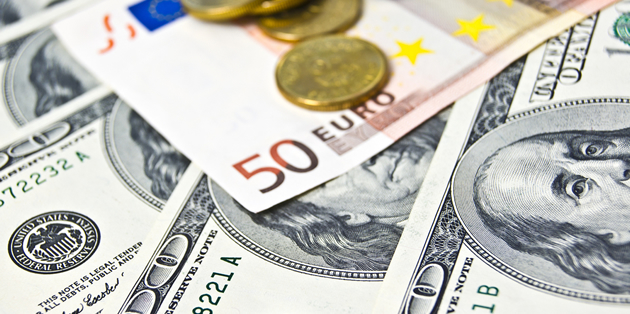Even though the odds of the Bank of England easing monetary policy at its September meeting have weakened the Pound has remained under pressure against the Euro and US Dollar.
- GBP exchange rates muted in spite of steady UK inflation – Pound weakness failed to feed through into economy in August
- Euro remained on stronger footing despite renewed Greek worries – German CPI showed no change
- Fed rate hike odds dropped in response to dovish Brainard speech – Policymaker stressed need for gradual interest rate rise
- Weaker ZEW Economic Sentiment Survey forecast to boost GBP EUR exchange rate – Softer confidence would undermine Euro appeal
BoE Easing Fears Held Pound Exchange Rates on Downtrend
The Pound continued to plummet throughout Tuesday’s European session, with nothing to distract investors from the disappointment of the day’s inflation data. With the chances of further BoE easing seeming to have risen on the back of the steady inflation figure the appeal of Sterling has weakened significantly.
As a result the GBP EUR exchange rate was slumped at 1.1722, while the GBP USD pairing was trending lower in the region of 1.3172.
(Previously updated at 16:33 on 13/09/16)
Safe-haven demand has continued to support the US Dollar, meanwhile, despite increasing speculation that the Fed could leave interest rates unchanged for longer.
Pound (GBP) Exchange Rates Remain Muted Despite Unchanged UK Inflation
It was not an overly encouraging start to the week for the Pound (GBP) as the British Chambers of Commerce lowered its forecasts for UK growth. This was coupled with a fresh warning over the potential negative impact that Brexit-based uncertainty could have on the domestic economy in the long term, with a lack of clarity likely to discourage confidence. Even so, GBP exchange rates returned to a stronger footing later on Monday in the absence of any fresh domestic data. In large part this was due to the increasing conviction that the Bank of England (BoE) will hold off on cutting interest rates further on Thursday.
Ahead of August’s Consumer Price Index report Sterling had trended lower against a number of its rivals, weighed down by forecasts for a further uptick in domestic inflation. However, to the surprise of investors the figure instead held steady at 0.6% on the year, indicating that the weakness of the Pound had not particularly fed through into the wider economy. Even so, this was not enough to significantly boost the Pound, which is likely to remain volatile in anticipation of Wednesday’s crucial employment data.
GBP EUR Exchange Rate Forecast to Trend Higher on Soft ZEW Sentiment Survey
A bearish Sterling market mood has helped to keep the Euro (EUR) on an uptrend early in the week, despite resurgent concerns over the Greek bailout and its progress on reforms. Investors remained encouraged by the European Central Bank’s (ECB) lack of commitment to further monetary loosening measures at its September meeting. Although the finalised German Consumer Price Index for August provided no surprises this offered further encouragement to the single currency, suggesting that inflationary pressure remains on an uptrend, albeit a modest one.
Demand for the Euro could weaken on Tuesday afternoon, though, if the latest ZEW Economic Sentiment Surveys prove disappointing. Confidence in both Germany and the wider Eurozone took a dent in the wake of the UK’s vote to leave the EU, something which markets will be hoping to see reversed in September. However, sentiment in the Eurozone’s powerhouse economy may have remained fragile in response to other factors, as researchers at TDS noted:
‘Given the softer tone we’ve seen to some of the data in Q3 so far, we see downside risks and look for the current assessment to slip to 55.2 (mkt 56.0), and for expectations to fall to -3.0 (mkt +2.5).’
Lower Fed Rate Hike Odds Failed to Substantially Dent US Dollar (USD)
The odds of an imminent Federal Reserve interest rate hike were seen to weaken substantially in the wake of comments from policymaker Lael Brainard. Living up to her reputation as one of the most dovish members of the Federal Open Market Committee (FOMC), Brainard maintained the opinion that rates should only be raised gradually. As this seemed to put paid to speculation of a September move, given the mixed nature of recent US data, the ‘Greenback’ (USD) consequently lost some of its appeal.
Nevertheless, safe-haven demand remained heightened on Tuesday morning in spite of the lower pricing for an imminent Fed hike. This kept the Pound to US Dollar (GBP USD) exchange rate on a downtrend, with investors continuing to pile into the ‘Greenback’ as they shunned higher-risk assets. There could be further support for the US Dollar if the NFIB Small Business Optimism Index for August shows an uptick. So long as signs within the world’s largest economy continue to point towards resilience then markets are likely to maintain a positive outlook on USD exchange rates.
Current GBP, EUR, USD Exchange Rates
At the time of writing, the Pound to Euro (GBP EUR) exchange rate was trending narrowly around 1.1850, while the Pound to US Dollar (GBP USD) pairing was slumped in the region of 1.3314.



